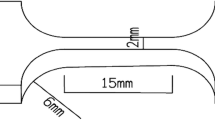Abstract
In this work, stress relaxation behavior of Sn3.5Ag0.5Cu solder joint was investigated under 398 K. Three strain ranges (4, 6, and 8 %) and two strain rates (0.002 and 0.01/s) were utilized. The results show that the effect of strain range on stress relaxation is not significant under high strain rate. However, it firstly increases with strain range and then decreases after approaching the maximum value under low strain rate. Moreover, Stress relaxes more under high strain rate than that under low strain rate. Feltham equation can describe the stress relaxation behavior well under high strain rate. After a certain relaxation time, crack appears at the corner of the solder joint and the stress appears to increase a little.




Similar content being viewed by others
References
Q.K. Zhang, Z.F. Zhang, Acta Mater. 59, 6017–6028 (2011)
S. Park, R. Dhakal, L. Lehman, E. Cotts, Acta Mater. 55, 3253–3260 (2007)
M.A. Matin, W.P. Vellinga, M.G.D. Geers, Mater. Sci. Eng. A. 445–446, 73–85 (2007)
H. Mavoori, J. Chin, S. Vaynman, B. Moran, L. Keer, M. Fine, J. Electron. Mater. 26, 783–790 (1997)
M. Novotny, I. Szendiuch, Acta electrotech. Inform. 6, 1–10 (2006)
G. Cuddalorepatta, D. Herkommer, A. Dasgupta. Proceeding of 8th International Conference on thermal, mechanical and multi-physics simulation experiments in microelectronics and micro-systems, London, April, 2007, IEEE, paper 1–8
S.G. Jadhav, T.R. Bieler, K.N. Subramanian, J.P. Lucas, J. Electron. Mater. 30, 1197–1205 (2001)
H. Rhee, K.N. Subramanian, J. Electron. Mater. 32, 1310–1316 (2003)
M.W. Woodmansee, R.W. Neu, Mater. Sci. Eng. A. 322, 79–88 (2002)
H. Rhee, K.N. Subramanian, Solder Surf. Mt. Technol. 18, 19–28 (2006)
E.W. Hare, J. Electron. Mater. 24, 1473–1484 (1995)
Y. Kanda, Y. Kariya, Microelectron. Reliab. 52, 1435–1440 (2012)
W.H. Bang, K.H. OH, J.P. Jung, J.W. Morris, F. Hua, J. Electron. Mater. 34, 1287–1300 (2005)
R. Mahmudi, A.R. Bazzaz, H.R.B. Fard, J. Alloy. Compd. 429, 192–197 (2007)
W.M. Payten, D.W. Dean, K.U. Snowden, Mater. Sci. Eng. A. 527, 1920–1925 (2010)
R. Hales, Fatigue Fract. Eng. Mater. Struct. 6, 121–135 (1983)
R. Gao, X. Li, Y. Zhu, J Mater Sci: Mater Electron. (2015). doi:10.1007/s10854-015-2664-5
K. Hariharan, O. Majidi, C. Kim, M.G. Lee, F. Barlat, Mater. Design. 52, 284–288 (2013)
X.Q. Shi, W. Zhou, H.L.J. Pang, Z.P. Wang, ASME J. Electron. Packag. 121, 179–185 (1999)
P. Schall, M. Feuerbacher, M. Bartsch, U. Messerschmidt, K. Urban, Philos. Mag. Lett. 79, 785–796 (1999)
Y.X. Zhu, X.Y. Li, R.T. Gao, C. Wang, J Mater Sci: Mater Electron. 25, 3863–3869 (2014)
Acknowledgments
This study was financially supported by National Natural Science Foundation of China (No. 51275007) and Key Project of Scientific Research Plan of Beijing Municipal Education Commission (No. KZ201410005009).
Author information
Authors and Affiliations
Corresponding author
Rights and permissions
About this article
Cite this article
Zhu, Y., Li, X. & Gao, R. Stress relaxation behavior of lead-free solder joint. J Mater Sci: Mater Electron 26, 3020–3024 (2015). https://doi.org/10.1007/s10854-015-2792-y
Received:
Accepted:
Published:
Issue Date:
DOI: https://doi.org/10.1007/s10854-015-2792-y




